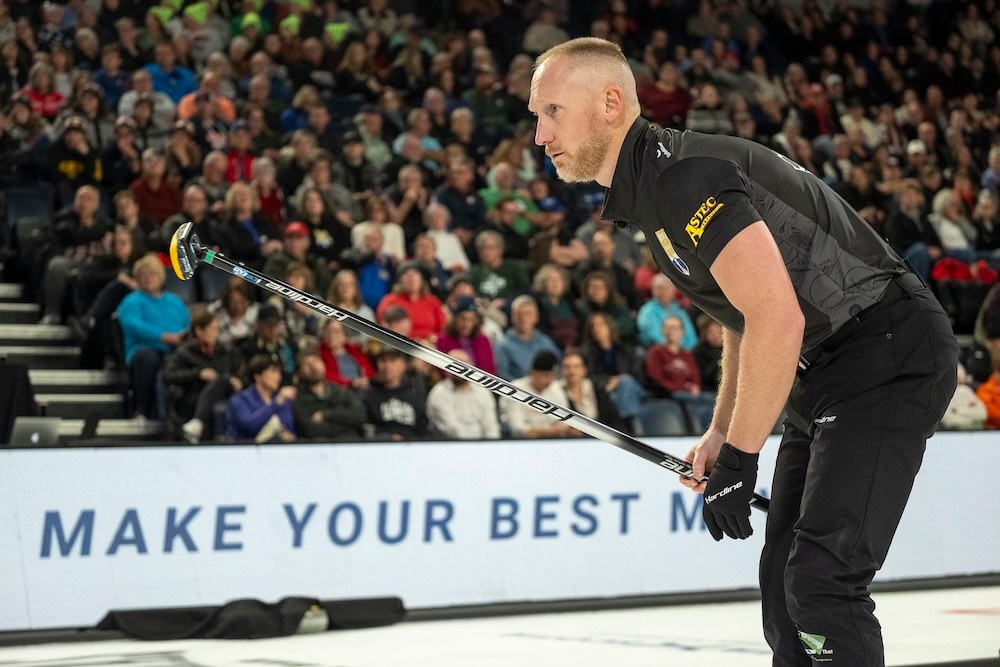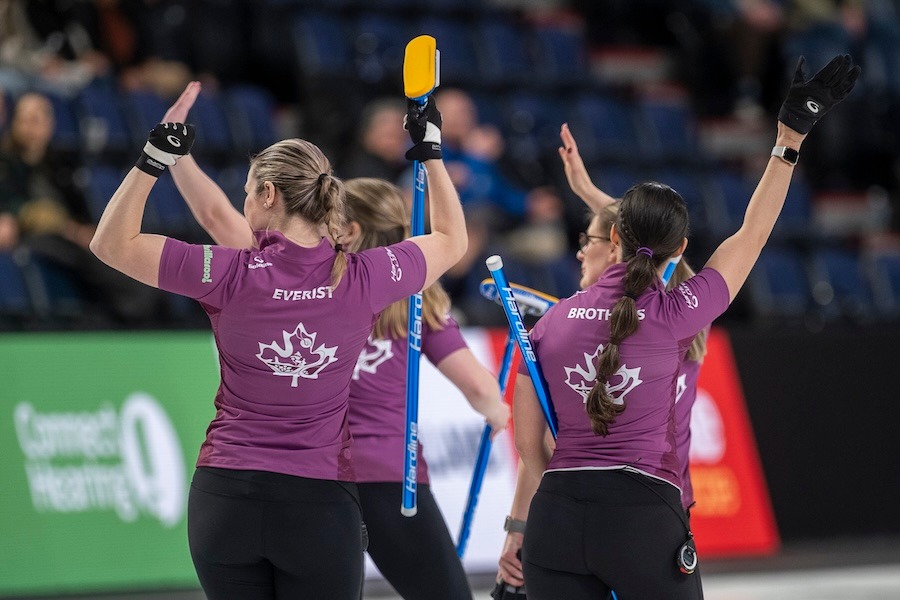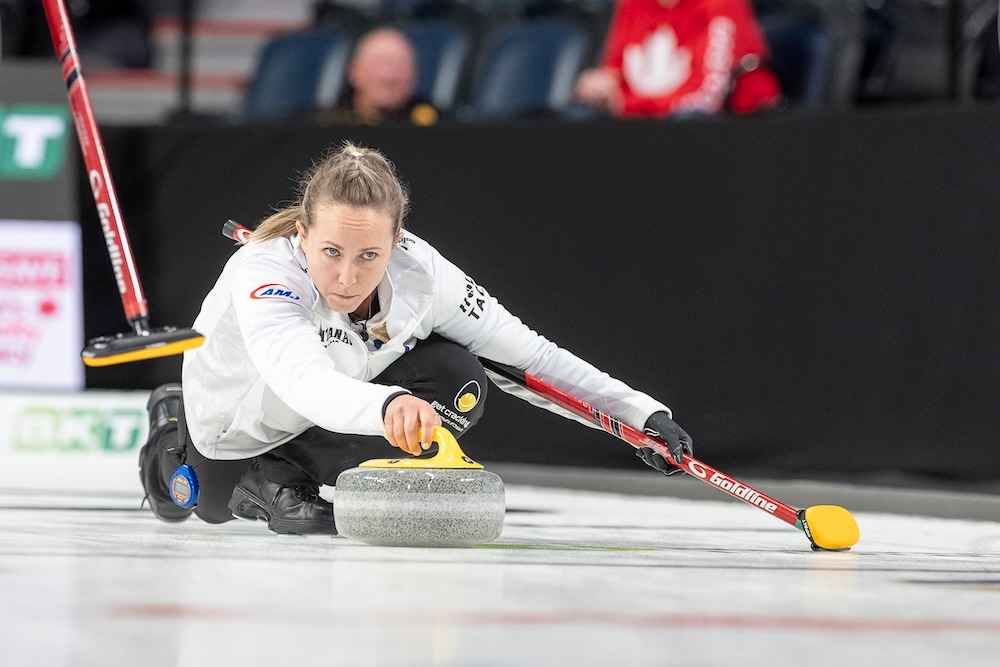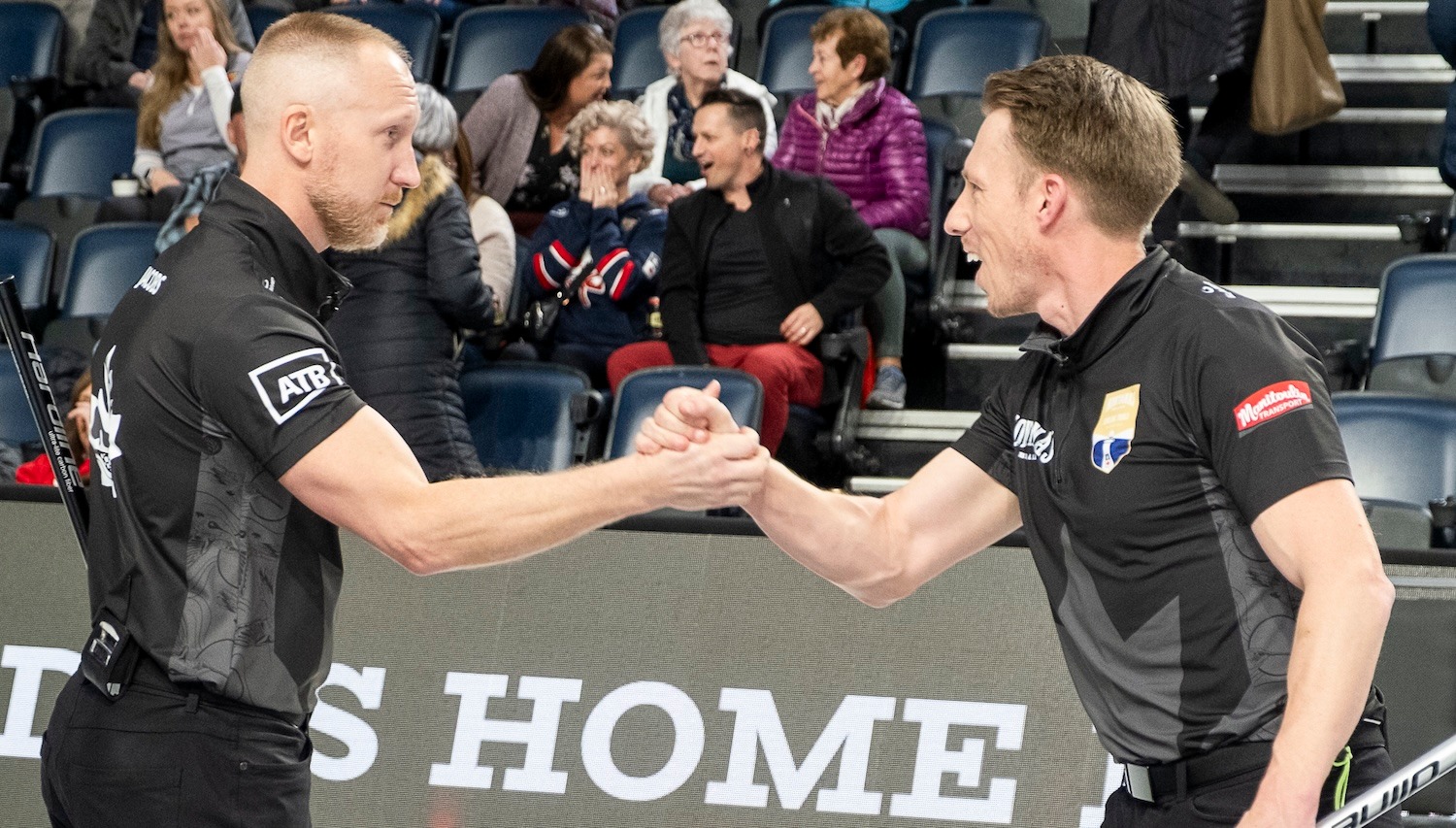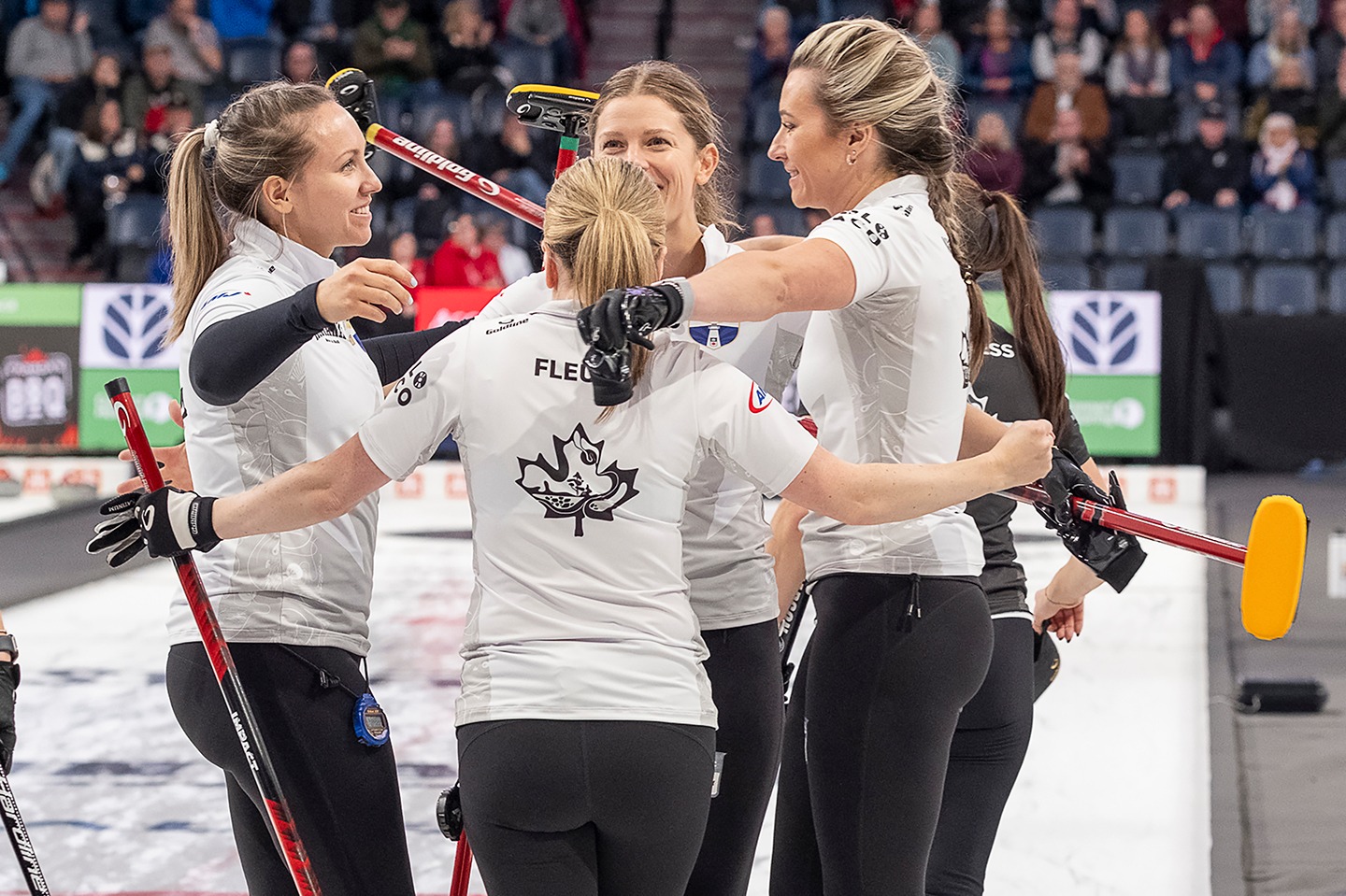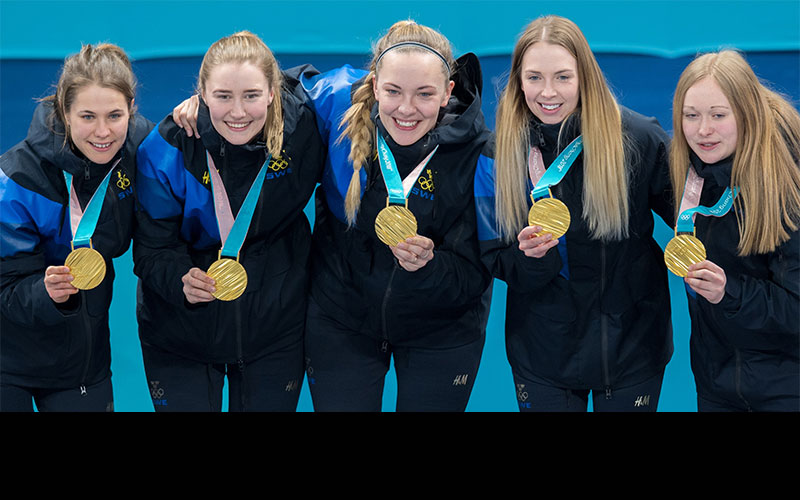 By Price Atkinson - When Sweden's Team Hasselborg, skip Anna Hasselborg, third Sara McManus, second Agnes Knochenhauser and lead Sofia Mabergs (team photo by Rich Harmer) along with coach Maria Prytz stepped on the ice in the Olympic Gold Medal game against Korea, the plan was exactly that - simple. Specifically, to keep the middle open and don't let their Korean opponents create an opportunity to steal. It seems standard, but the team of EunJung Kim from Uiseong, affectionately known as the 'Garlic Girls' hadn't made it easy on anyone all week. They handled many of the top teams in the world and reached the Winter Olympics final with one loss. "The stats could give us an idea of how the Koreans were scoring their points and how they won their games, that is, what they also would be comfortable with. If we could make them play another game we could maybe take them a little bit out of their comfort zone," Hasselborg said. "It also made us comfortable with the game plan that we would play which also made us confident and secure out there." Analytics are increasingly being used in sports to find advantages over opponents and curling is no different. For several years, CurlingZone President/CEO Gerry Geurts has been working to bring a more analytical approach to curling. Fundamentally, to change the way coaches, players and even fans look at the game. In 2000, he launched CurlingZone.com, which has turned into the most visited independent curling website where fans of the sport can get scores, the latest news and join the raucous chat forums for banter about the sport. Growing behind the scenes since that time has been a collection of line scores Geurts has compiled. With over 175,000 games in the database, CurlingZone has built the most extensive research base for the sport. By collecting around 10,000 line scores per season, Geurts has been able to translate that into a knowledge base shared with television broadcasts and with increasingly information-hungry teams. "I understood there was value in the numbers from the start, the opportunity to build a database of statistics was a really neat opportunity to learn more about the game," Geurts said. "Curling is a turn-based game with so many decisions made throughout the game that can affect your chances of winning." Through the teams.curlingzone.com website, players have access to information on how teams start with and without hammer and how they handle late-game situations. The information you often hear shared during the Winter Olympics on CBC in Canada, NBC in the United States and for many years through Sportsnet from the Grand Slam of Curling is available on every opponent. "Being a big baseball fan, I've been a numbers guy since I was a kid," Geurts said of his introduction to numbers and statistics. "When I was little, I'd sit around listening to the Toronto Blue Jays on the radio and would keep score of the games. Before I knew how it was supposed to be done, I had my own system of charting the games with stars for runs, checkmarks for rbis and so on." In 2001, the best-selling book "Moneyball" was published, telling the story of the Oakland Athletics and Billy Beane and how he built a baseball team through analytics. As a general manager of a low-payroll team, Beane used statistics to determine undervalued and overvalued characteristics in the sport and constructed the Athletics roster based on efficiency that went on to have a lot of success. "I saw Moneyball as an awakening in how to look at the game," Geurts said. "I was just getting involved in curling at the time, building a live scoring system for the Ontario Curling Tour. Then doing the same for the World Curling Tour, I saw an opportunity to collect a wide array of information that could be analyzed." From that the Efficiency Stats were unveiled, which helped to better understand scoring and defense in the game of curling. Hammer Efficiency calculates the percentage of time a team scores two or more with hammer (excluding blank end). Steal Defense is the percentage of time a team gives up steals compared to Force Efficiency which calculates the percentage of time a team gives up two or more when scored up without hammer. Steal Effiency is the percentage of steals a team takes. In 2004 at the Players Championship in St. John's, Newfoundland & Labrador, this information was displayed for the first time on broadcasts alongside line scores and results from the event. With help from Dallas Bittle and George Karrys, the "Black Book of Curling" was published with the first of three editions going live for the 2005-06 season. The book displayed detailed statistical information on the top teams around the world and contained an article that was the first to prove that being up one without hammer was statistically superior to being down 1 with hammer. "It was a long-held belief that being down 1 with hammer in the last end was the preferred position to the opposite (up 1 without), but with the numbers we were able to show that teams were only winning about 40% of the time," Geurts said. "It's all about being in control of the situation and no team enjoys standing on the backboards watching their opponent throw a potential game winning shot and having that hammer stone in their hands would prevent that." "Teams would never play enough of any one situation in a season to get a proper sample size to understand the numbers, and the better teams typically tended to win more than the average in both scenarios, so again they were not getting a good comparison." The influence of statistics began to grow with the "Black Book" catching the attention of Scott Higgins. Higgins was tasked with developing a High Performance program for the United States Curling Association ahead of the 2010 Winter Olympics in Vancouver. He pulled together a team of experienced minds, incorporating sports psychology, nutrition and fitness as well as team dynamics work by Rodger Schmidt of Switzerland. Unfortunately for Higgins and the team, many of the concepts were ahead of their time and the curling culture was not ready to adopt such a massive change. After the Olympics where both teams performed below expectations, a lot of the information was then put to use in the post-mortem, analyzing why the teams did not succeed. Geurts gained more insight immediately following the 2010 Olympics when he had the opportunity to coach at the 2010 USA Curling National Championships in Kalamazoo, Michigan. Matt Hames, Bill Stopera, Martin Sather and Dean Gemmell were just looking for someone to sit on their bench and provide them with extra time to chat in timeouts, as walking time was provided to teams who actually employed a coach. Bringing along the information and analysis provided to the Olympic teams, Geurts found a more interested skip in Hames and an engaged team in what the numbers showed regarding possible advantages and disadvantages. For a squad that hadn't been together long, the numbers helped them focus on the opening ends and the best decision making on how to attack each opponent. "Analytics were a new way to look at curling, but we were a new team and needed any advantages we could get," Hames said. "Before Gerry the binary decision in the first end was keep it open or mix it up, while this data led to more nuanced decision-making. I felt like I had an advantage in the first end." Hames opened the 2010 Nationals with five straight wins, finishing the round-robin 6-3. They went on to lose the Page 3v4 game, a solid result for the team who came in with little expectations. "What I learned from this experience was that feeding a few pieces of information through the coaches to the team was inefficient," Geurts said. "I needed a team interested in utilizing this information to plan their attack." Geurts had speaking opportunities, trips to visit curlers and lots of discussion about numbers, but nothing significant came of the work he did until several years later, a chance meeting with Jacqueline Harrison and her Mississauga, Ontario based team of Janet Murphy, Stephanie Matheson and Melissa Foster. This team of thinkers had a thirst for information and Geurts analyzed Rachel Homan's team and their tactical approach early in games. The relationship began with some informal discussion on how Homan approached the first end of games. Homan was blanking the first end around 60-70% of the time and was frustrating to see teams let her have her way. The tick shot was such a weapon for Homan that no one challenged her to try and take that advantage away. Harrison played in the 2016 Ontario Scotties and did exactly that. They threw a centre guard against Homan in the first end and put rocks in play, forcing her into tough decisions early in the game. For Harrison both the round-robin and Page 1v2 game was a success where they stole the first end. Unfortunately for them the wheels fell off in the second ends where they gave up a three and four respectively. The team saw the opportunity and instead of giving up on a idea, they doubled down and continued to refine their game. "The team was amazing to work with and they soaked up the knowledge available, while continuing to dig for more," Geurts said. Harrison's team had qualified for their first Grand Slam of Curling event, the 2016 Champions Cup in Alberta and were looking for some help on 5-rock strategy and the discussion evolved into deeper analytics from there. After their Grand Slam experience, the opportunity to work with the team for their Grand Slam Tour Challenge Tier 2 event in November 2016 in Cranbrook, British Columbia came together. "These detailed statistical reports broke down game scenarios of our opponents end by end which allowed us to identify specific trends and patterns," said Harrison. "We could then formulate a tailored set of game tactics for each team based on their identified areas of strength and weakness. We were able to pinpoint areas where we could afford to take calculated risks as well as where we could take a more conservative approach." Harrison went on the win the Tier 2 event, clinching a spot into the January 2017 Canadian Open in North Battletford, Saskatchewan. The win also eventually earned them a spot in the end-of-season Champions Cup. After another game against Homan in a World Curling Tour event, it gave Harrison even more confidence. Despite losing, they forced Homan to make her last shot to win, setting up the scene where the No. 16 seeded Harrison faced off against top-seeded Homan in the opening draw of the Canadian Open in January 2017. Homan won the hammer to open, but Harrison again stole the first end, controlled the game and went on to get their first-ever win against Homan. The Canadian Open was a triple knockout event that saw Harrison lose twice and find themselves in the C-qualifier where they faced Homan again. The event had been a success for Harrison in getting that far. With expectations low and a Homan team who had never missed the playoffs in previous Slams, it was an interesting turn of events as Harrison again wound up on the winning side. "Studying these analytics served us well as we were able to put ourselves in better positions to control play successfully while pushing our opposition out of their comfort zone," said Harrison. "We continued to successfully work with Gerry and used this approach on route to our Tier 2 Tour Challenge win, playoff appearances at multiple Grand Slam events as well as the 2017 Ontario Scotties Final." For Harrison, their high water-mark ranking was achieved in September 2017 was a point of pride, reaching 9th overall in the World. "I am sure we will see more teams making use of the analytics going forward as our sport continues to grow. For us, it was a key piece of the puzzle that contributed to our growth and success as a team," added Harrison. Stepping back to earlier that season, Team Hasselborg played their first-two events of the 2016-17 season in Oakville, Ontario where they won the Oakville Fall Classic, then made the quarterfinals in the larger Stu Sells Tankard where the discussion about numbers and analytics first began. "In the beginning of the 2016-17 season, we started the dialogue with Gerry, just talking about what we could do with the numbers," second Agnes Knochenhauer said. "CurlingZone gave us a whole new dimension in looking at the statistics of our own and other teams." At the Canadian Open, Hasselborg took a deeper look at the analytics available and the opportunities Geurts and CurlingZone's data had to supplement analytical work they had been doing on their own. Hasselborg's plan to build a team capable of winning Olympic Gold dates back to the summer of 2016. The team borrowed money from family, trained and did all the fitness work needed to be at the top of the game. But something most don't know about the Swedish foursome was their dive into numbers and analytics began on their own. Hasselborg started the season ranked 22nd on the Order of Merit World Team Ranking System, two spots behind the 20th-ranked Harrison. "I looked to other sports and poker and saw how much the statistical information was used. I thought it was strange that in a sport like curling where we constantly use odds and risk and award judgements that we didn't used this type of statistical information about your team and also your opponents game," Hasselborg said. "I wanted to connect a feeling about how we played and what our strengths and weaknesses were with some simple and hard facts." Hasselborg and her squad dug through he World Curling Tour and CurlingZone websites to pull all kinds of information on their own team in order to figure out their strengths and weaknesses and ways to elevate their game. "Anna's dad planted the seed many years ago when we were juniors," Knochenhauer said. "We evaluated ourselves and our strengths and weaknesses, both individually and as a team. We took it further when Anna used the whole summer 2016 to go through the scoreboards from our first season together and put a lot of material together. We compared it to the numbers of our best opponents to get a picture of what we needed to do to get better quickly." Geurts developed a plan with Hasselborg to do a test event in order to see if there was a fit and an opportunity to work together. Hasselborg and Harrison ended up in the same pool at the Champions Cup, so working with both teams presented a challenge for Geurts. He was open with both teams and each made the playoffs where they met for the second time in the semifinals. This was Harrison's deepest run at a Slam and for Hasselborg, they built confidence from the numbers. The teams both played aggressively with Hasselborg winning and advancing to the final, where they dropped a close game to Homan on the final rock (their best ever result in the Slams at the time). Hasselborg applied for funding from the Swedish Olympic Committee, hoping to further the opportunity to utilize the analytical information full time in the 2017-18 Olympic season. The goal to build profiles and track information throughout the season on potential opponents and building toward their ultimate potential. "We started creating gameplans based on their opponents first ends with and without hammer, and the end game scenarios where we looked at how strong a team was at holding leads late," Geurts said. "A strong opponent meant you had to take some chances, roll the dice if you found yourself behind while a weaker opponent that gave some games away later, you would plan to play a little more patiently and let the game come to you." It didn't take long for Hasselborg to breakout. Giving up a steal in the final end was a tough loss in the final of the Grand Slam Tour Challenge to Val Sweeting in September, followed by an extra end loss in Edmonton at The Shoot-out where Eve Muirhead score three and stole the extra end had some people wondering if this team had the finish to win when it matter. For Hasselborg and the team, they dug deep and learned a lot from those games. Mature beyond their years, the team found positives to take from both games and continued their statistical dominance over the women's field. They rose to take over the number one ranking on the Order of Merit World Rankings, though without a major win under their belt, there were still some questions to be answered. "For Hasselborg it was just a matter of gaining experience, looking back at the journey there would be very few people who could have seen this team be a gold-medal contender as little as 18 months ago," Geurts said. "They had some much potential and so much talent, and the minds to quickly rise through the ranks in the womein's field, the only thing that they needed was more experience in big games." Team Hasselborg continued to play well all season, making the playoffs in every event until their last before the Olympics, where admittedly their focus was split between final preparations for Pyeongchang and the games in front of them. Late night sessions and analysis created the plans necessary to attack each opponent differently, based on their strengths and weaknesses and even found some changes in approach in a few opponents this season. Switzerland's Silvana Tirinzoni had changed their game plan, turning to a more defensive style overall. Previously they had been an aggressive team which made them a very tough team to score multiples with the hammer against. But suddenly their underlying metrics showed that this had changed for this past season. It was something that Hasselborg and team had remarked about, remembering in their games this season that they scored more easily with hammer against Tirinzoni. This more defensive style did make the Swiss team better with the hammer. In the past, Tirinzoni had always been a strong team scoring with the last shot, but playing an aggressive game led to giving up too many steals. This aggression had also served them well without the hammer generating a lot more steal opportunities for them, along with the resulting forces that come with making shots and playing aggressive without the hammer. "After tracking Tirinzoni's recent game play, we noted that to beat Silvana, you needed to put lots of rocks in play when she had the hammer, enticing her back into some old tendencies," Geurts said. "Having this knowledge also allowed us to take advantage of their more open play without hammer to generate deuces." There were teams in Pyeongchang that Hasselborg played very aggressively against. They put rocks in play and applied constant pressure, a strategy that has had success against Homan in the past and their win over the Canadian foursome early in round robin was their first win as a team and a major building block for the week. There were teams in the round robin who historically didn't finish strong and liked to jam the middle with rocks that Hasselborg played an open and patient style against. "To already be one step ahead even before the game started was an advantage," lead Sofia Mabergs said. "It also gave us some belief in what you think you see in the teams you play." The Swedes played with great confidence, all believing and executing the game plan while focusing on executing shot-by-shot. Verifying the statistical theories with some additional scouting to firm up game plans gave the Swedes an advantage that no one else had. "It always comes down to how well we perform out there on the ice. But what we could see when we started to work with the numbers was that our own performance in combination with the statistics gave us confidence in certain scenarios and patience in others," said Knochenhauer. "We're used the statistics to put the four of us on the same path, so that we all know how to take on each opponent. It gives us strength and courage as a team. It also shows the importance of each and every shot, from lead to skip, for us to be able to control the game. The numbers combined with our own experiences of every opponent gives us a good discussion on how to approach every team." After finishing the round-robin at 7-2 and tied for second place, a tough semifinal against Great Britain's Eve Muirhead awaited, but with hammer and precise game plan in place, Hasselborg executed with an open attack against Muirhead. They got an early two and then applied the pressure on Muirhead, ultimately winning out and sending Hasselborg to the final with unfinished business on their minds. Prior to facing Team Korea in the Gold medal game, Geurts took the Efficiency Stats and then broke down ends into scenarios where the Swedes could look at how the team handled scoring in each situation. Hasselborg had information that showed them that EunJung Kim's strength during the Olympics was their ability to steal points when they were down 1 without hammer, tied without hammer and up 1 without hammer and found they were posting Steal Efficiency rates between 40 to 50 percent. "Going back to the video and pairing the numbers with the eye test, we understood how this happened in that the Koreans were constantly putting rocks in the middle, making other teams uncomfortable," Geurts said. "Coupled with the team's strong play during the week, they won a lot of games playing this way." Geurts worked throughout the week with coach Maria Prytz to give the numbers some extra context during the games. To counter Korea's biggest strength, the game plan was set to play an open game with hammer and not let the Koreans have their typical opportunity. At the first hint of trouble, the plan was to hit and keep it open, knowing even scoring a single point was an acceptable result because the Koreans were an average team with hammer throughout the competition. "The stats played a major part because we knew how to play them to put them in an uncomfortable situation. We also knew what didn't work since we lost to them in the round robin getting trapped in their game plan," Knochenhauer remarked. "With stats from CurlingZone we knew what type of game they had been playing all week with great success and it was our job to break that and take advantage of the game." Hasselborg and the team executed the plan perfectly and dominated the game with an 8-3 win. It looked so simple, yet involved a lot of planning to ensure the right tactics were used. Analytics work continues to evolve as Geurts digs deeper into the numbers. Due to a lack of information or a common belief that playing many teams plays their own game plan and for a long time it's been good enough to win. "I see a lot of what happened to Homan at the Olympics was mostly due to the lack of adjusting their game plan," Geurts said. "They are a team who is the best in the world when they're comfortable, so in order to beat them you need to upset their balance." From game one, teams threw up the centre guard and challenged Homan from the very start of each game. It was a different approach than what Homan saw from most of their opponents at the 2017 World Championship. "Looking at Homan's undefeated run through the 2017 World Championships, you could see why they felt like they didn't need to make any changes." Team Homan was put into a position where they needed to adjust to their opponent's new found aggression, but not utilizing this information they got caught playing into the opposition's game plan. Losses to Korea and China, teams that tended to like a lot of rocks in play could have been avoided. However looking back at Homan's performance at the World Championships, they likely saw so need to change their game. Team Hasselborg has now set the bar for the rest of there world. Making shots and sticking to your own dedicated game plan is no longer enough. Teams now need to adapt and adjust more than ever to counter their opponent's well-laid plans and strategies. For Korea's Team Kim, they understood the concepts that they needed to be successful in the Olympics, utilizing analytics provided to them to help them win their Olympic Trials in March and April of 2017. The scouting reports provided by Geurts and CurlingZone helped them and the Uiseong men's team of Chang-Min Kim both win over other opponents. Geurts has been working with USA Curling's high performance program to develop and customize analytical strategies for teams, including the Olympic gold-medal winning team led by John Shuster. "He sat us down at our summer camp and explained to us where we sat [among] elite players at certain things, like with the hammer/without the hammer, up by one with the hammer/down by one with the hammer ? and it went on for all of the potential scoring scenarios," Team Shuster second Matt Hamilton said on the fivethirtyeight.com podcast after the Olympics. "And he gave us feedback [on] which positions we could be better at, which ones we're really good at, where we need to keep doing what we're doing. Then he gave us some info on other teams in those same kind of numbers. ? I'd be lying if I said that didn't come into play at all." The training camp at the US Olympic Committee headquarters in Colorado Springs saw an opportunity for all six high performance teams to learn more about the analytics and how to use them to be better teams. Of the teams, Jamie Sinclair and Heath McCormick continued to use the numbers provided to develop game-plans throughout the season. "It took eight years for the basic principles to develop during the lead up to the 2010 Olympics in Vancouver to help win an Olympic Gold Medal," Geurts said reflecting on the journey. "The lessons learned in Moneyball by Billy Beane and how long it took for other Major League Baseball teams to adopt the concepts were similar and in developing this information we knew it would eventually pay off. "It was a matter of time before we found a team that thought about the game differently, with Harrison first and then Hasselborg taking it to the next level. It's been a neat experience to tag along." The next steps are becoming more obvious as teams continue to reach out and show interest in the opportunities. Smart minds like Kevin Palmer of the Curling with Math blog, who utilizes the CurlingZone numbers to write his deep math analysis on decision making by teams, Canadian Jason Gunnlaugson who utlized numbers during the season and others expressing interest in getting more involved and bringing this level of knowledge to more teams. "We've just scratched the surface of what is possible in this game," Geurts said. "The work we've done so far still feels very rudimentary and basic. But we also understand human nature and what it takes for teams to do things differently. It's a whole new world as curling grows up, joining many other major sports in embracing evidence-based decision making." |


